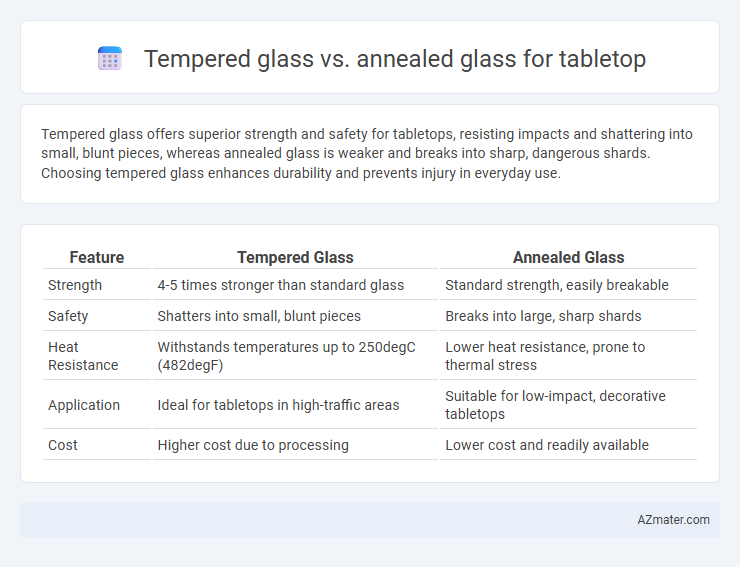Tempered glass offers superior strength and safety for tabletops, resisting impacts and shattering into small, blunt pieces, whereas annealed glass is weaker and breaks into sharp, dangerous shards. Choosing tempered glass enhances durability and prevents injury in everyday use.
Table of Comparison
| Feature | Tempered Glass | Annealed Glass |
|---|---|---|
| Strength | 4-5 times stronger than standard glass | Standard strength, easily breakable |
| Safety | Shatters into small, blunt pieces | Breaks into large, sharp shards |
| Heat Resistance | Withstands temperatures up to 250degC (482degF) | Lower heat resistance, prone to thermal stress |
| Application | Ideal for tabletops in high-traffic areas | Suitable for low-impact, decorative tabletops |
| Cost | Higher cost due to processing | Lower cost and readily available |
Introduction: Tempered vs Annealed Glass for Tabletops
Tempered glass for tabletops offers superior strength and safety due to its heat-treatment process, making it resistant to impact and thermal stress. Annealed glass, while providing clarity and cost-effectiveness, is more prone to breakage and offers less durability under heavy use. Choosing tempered glass enhances safety and longevity for tabletops exposed to daily wear and potential impact.
What Is Tempered Glass?
Tempered glass, also known as toughened glass, undergoes a thermal or chemical treatment process that increases its strength compared to annealed glass, making it highly resistant to impact and thermal stress. This type of glass is designed to break into small, blunt pieces rather than sharp shards, enhancing safety for tabletop applications. Its durability and safety features make tempered glass an ideal choice for dining tables, coffee tables, and other surfaces that require both strength and aesthetic appeal.
What Is Annealed Glass?
Annealed glass is a type of glass that is slowly cooled during manufacturing to relieve internal stresses, making it more susceptible to breakage compared to tempered glass. It is often used for tabletops where impact resistance is less critical, providing a smooth, clear surface that can be easily cut or shaped. Unlike tempered glass, annealed glass breaks into large, sharp shards, posing a greater safety risk if broken.
Strength and Durability Comparison
Tempered glass for tabletops offers superior strength, being approximately four to five times stronger than annealed glass, making it highly resistant to impact and thermal stress. Its durability stems from a heat treatment process that induces compressive stresses on the surface, reducing the risk of shattering under everyday use. Annealed glass, conversely, lacks this reinforced structure, rendering it more susceptible to cracking and breakage, especially under heavy loads or sudden temperature changes.
Safety Features: Tempered vs Annealed
Tempered glass for tabletops offers significantly enhanced safety features compared to annealed glass due to its increased strength and shatter-resistant properties. When broken, tempered glass fragments into small, blunt pieces that reduce the risk of injury, whereas annealed glass breaks into large, sharp shards that can cause severe harm. These safety advantages make tempered glass the preferred choice for high-traffic or family environments requiring durable and secure surfaces.
Aesthetic Differences and Edge Quality
Tempered glass for tabletops features a sleek, uniform appearance with sharper, more defined edges thanks to the heat treatment process that enhances strength and safety. Annealed glass, while offering a smoother, softer edge profile, may exhibit slight imperfections or distortions that affect clarity and visual appeal. The polished edges of tempered glass provide a modern, high-end look preferred in contemporary furniture designs, whereas annealed glass lends a more traditional and understated aesthetic.
Cost Comparison: Which is More Affordable?
Annealed glass is generally more affordable than tempered glass due to its simpler manufacturing process and lack of heat treatment, making it a cost-effective choice for tabletops. Tempered glass, while more durable and resistant to impacts, incurs higher production costs that result in increased prices for consumers. For budget-conscious buyers prioritizing safety and strength, the additional investment in tempered glass may offer better long-term value despite the higher upfront cost.
Suitability for Tabletop Applications
Tempered glass offers superior strength and safety for tabletops, with a resistance to impact four to five times greater than annealed glass, making it highly suitable for high-traffic or family environments. Its ability to break into small, less harmful granules reduces injury risk, while annealed glass, being more prone to cracking and shattering into sharp shards, is better suited for low-impact, decorative tabletop applications. The enhanced thermal and mechanical durability of tempered glass ensures longevity and reliability in everyday use.
Maintenance and Longevity
Tempered glass offers superior durability and scratch resistance compared to annealed glass, making it easier to maintain for tabletops as it withstands daily wear and tear without compromising clarity. Annealed glass, being more prone to chipping and breaking, requires careful handling and frequent replacement, reducing its longevity in high-use environments. The enhanced strength and shatter-resistance of tempered glass significantly extend the lifespan of tabletops, providing a safer and more cost-effective investment over time.
Which Glass Type is Best for Your Tabletop?
Tempered glass offers superior strength and safety for tabletops, as it is four to five times stronger than annealed glass and shatters into small, blunt pieces rather than sharp shards. Annealed glass is more prone to breaking under impact and stress, making it less ideal for high-traffic or frequently used tabletops. For durability and safety, tempered glass is the best choice for a tabletop, especially in homes with children or heavy use.

Infographic: Tempered glass vs Annealed glass for Tabletop
 azmater.com
azmater.com